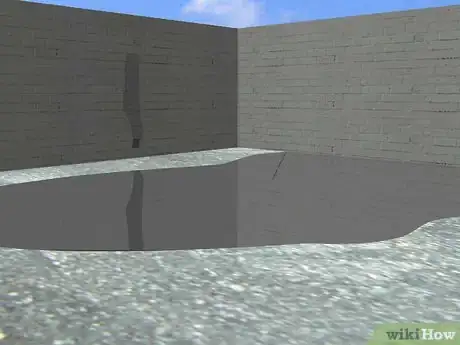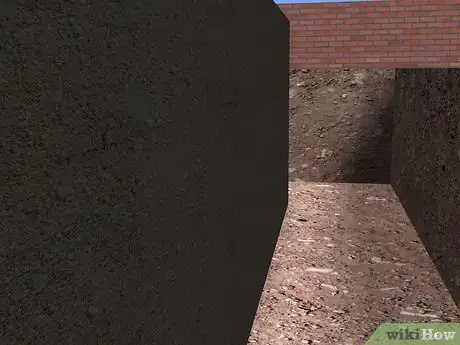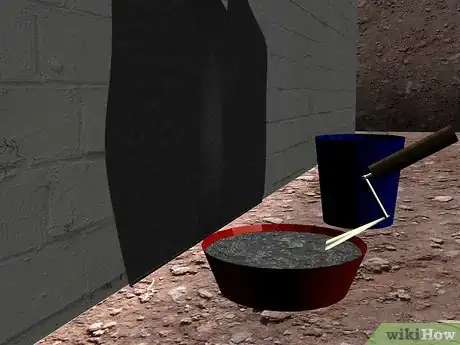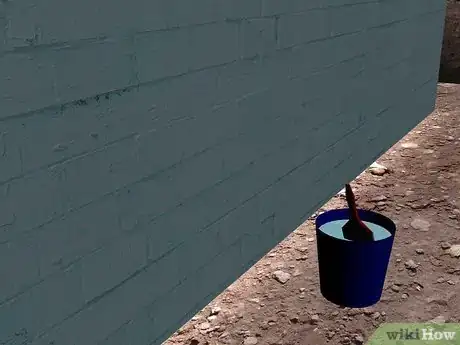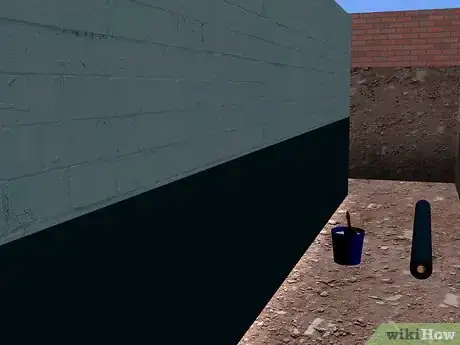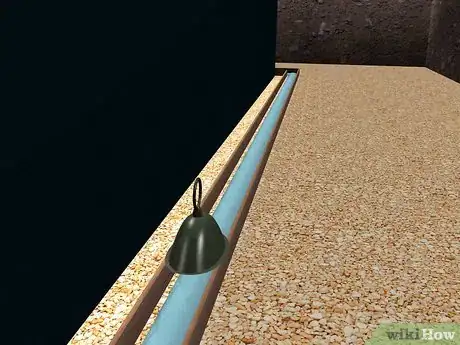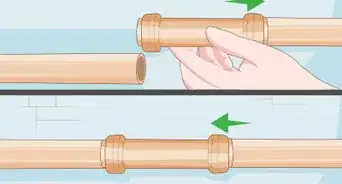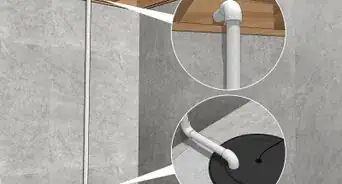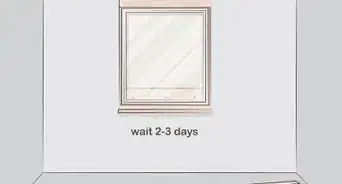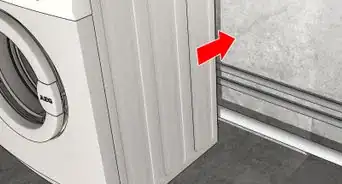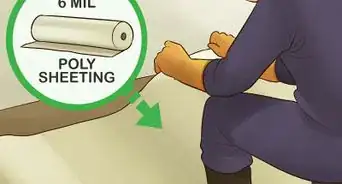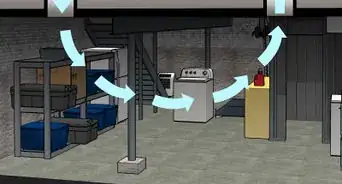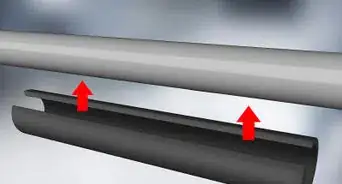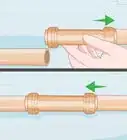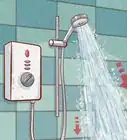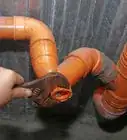X
wikiHow is a “wiki,” similar to Wikipedia, which means that many of our articles are co-written by multiple authors. To create this article, 12 people, some anonymous, worked to edit and improve it over time.
This article has been viewed 98,241 times.
Learn more...
Leaking basements, aside from causing costly property damage, could lead to the growth of mold. To prevent potential health hazards and extensive damage to the structure of the house any water penetration should be identified and fixed. Here are some tips on how to eliminate leaks in the basement.
Steps
-
1Inspect and identify source of leak (ie crack in the wall, leaking window, etc). Look carefully at organic surfaces such as wood, drywall, and carpets in a finished basement.[1]
-
2Dig down 6 feet (1.8 m) to the foundation all around outside of the house. The width of the trench should be enough for doing some other steps on the bottom. You need enough space for patching the foundation and installing draining pipe.[2]Advertisement
-
3Pressure wash foundation and let it dry. Use heavy duty brush to clean up the surface of the foundation if water presser does not clean up all dirt from the wall. Make a slight incline in the patched area, slanting it from the floor upward toward the wall. This provides extra strength to the patched area and helps drain away any moisture that might accumulate in the future
-
4Patch the cracks. Apply small amounts of the cement mix into the chipped-out area and smooth it out with an ordinary trowel.[3]
-
5Apply waterproofing paint sealer. You can purchase epoxy or latex waterproof mixes for treating walls. Most of these mixes require you to add only water. If you use this type of mix, be sure to follow the manufacturer's instructions carefully.[4]
-
6Install waterproofing membrane. Dimpled Membrane is made from tough, long lasting plastic that keeps exterior moisture out. It prevents back fill material from touching the foundation wall and bridges typical wall cracks with ease.[5]
-
7Run drainage pipe around the foundation to insure ground waters stay away from the walls. As seen in the picture, a footing drain rests just outside of a house’s foundation. Most often, this pipe is laid in a bed of loose gravel meant to keep dirt from entering. The pipe is thick, with 1/2" spaces in it, and stone is laid on top of it.
-
8Fill the trench with soil that you took out before. Compress the soil every.
Advertisement
Expert Q&A
-
QuestionHow can I prevent water from seeping in through basement walls?
 Ryan OwsianyRyan Owsiany is a Drywall and Painting Specialist and the Owner of Patch and Paint Pros in Conshohocken, Pennsylvania. With over two decades of experience, Ryan specializes in interior and exterior house painting as well as drywall, plaster, and water damage repair. Ryan holds a BS in Industrial Engineering from Penn State University. Patch and Paint Pros only employ experienced, friendly painters that understand proper preparation is required to ensure client satisfaction on every painting project.
Ryan OwsianyRyan Owsiany is a Drywall and Painting Specialist and the Owner of Patch and Paint Pros in Conshohocken, Pennsylvania. With over two decades of experience, Ryan specializes in interior and exterior house painting as well as drywall, plaster, and water damage repair. Ryan holds a BS in Industrial Engineering from Penn State University. Patch and Paint Pros only employ experienced, friendly painters that understand proper preparation is required to ensure client satisfaction on every painting project.
Drywall & Painting Specialist One of the best ways of preventing seeping without digging up the ground around your house and tarring the outside of the block is to have a landscaper come out and grade the land around the foundation. This method will make the land a couple of inches higher where it meets the wall, and then it slopes down and away from the house. That little bit of landscaping can go a long way toward preventing the water from seeping down along the foundation walls. You can also walk around your house and look for little dips in the ground next to the wall. Then fill them up with dirt, and pack them tight otherwise the hole will get bigger.
One of the best ways of preventing seeping without digging up the ground around your house and tarring the outside of the block is to have a landscaper come out and grade the land around the foundation. This method will make the land a couple of inches higher where it meets the wall, and then it slopes down and away from the house. That little bit of landscaping can go a long way toward preventing the water from seeping down along the foundation walls. You can also walk around your house and look for little dips in the ground next to the wall. Then fill them up with dirt, and pack them tight otherwise the hole will get bigger. -
QuestionHow can I get rid of water in a basement?
 Ryan OwsianyRyan Owsiany is a Drywall and Painting Specialist and the Owner of Patch and Paint Pros in Conshohocken, Pennsylvania. With over two decades of experience, Ryan specializes in interior and exterior house painting as well as drywall, plaster, and water damage repair. Ryan holds a BS in Industrial Engineering from Penn State University. Patch and Paint Pros only employ experienced, friendly painters that understand proper preparation is required to ensure client satisfaction on every painting project.
Ryan OwsianyRyan Owsiany is a Drywall and Painting Specialist and the Owner of Patch and Paint Pros in Conshohocken, Pennsylvania. With over two decades of experience, Ryan specializes in interior and exterior house painting as well as drywall, plaster, and water damage repair. Ryan holds a BS in Industrial Engineering from Penn State University. Patch and Paint Pros only employ experienced, friendly painters that understand proper preparation is required to ensure client satisfaction on every painting project.
Drywall & Painting Specialist If the water is really bad, and you actually have half an inch of water or more on the floor, I would get a Shop-Vac. Get one that's indicated for wet or dry. Then you typically have to remove the dry filter when you're doing this.
If the water is really bad, and you actually have half an inch of water or more on the floor, I would get a Shop-Vac. Get one that's indicated for wet or dry. Then you typically have to remove the dry filter when you're doing this. -
QuestionI have outside concrete steps. When it rains, water comes through the basement wall in that area. Can I fix it without digging down to the foundation on the outside?
 Community AnswerTypically, yes. The leak wasn't present (most likely) when the place was new, so study the outside for water puddles, cracks in the stair or basement wall, or (if present) a dirty, clogged, or improper bulkhead door's drainage and water run away system. You may need to just add a bag of dirt to re-grade soil or pavers with a very minor pitch for water to run away from the stairs instead of towards. Cracks can be mortared or caulked, but only in addition to re-grading; you never want water to collect anywhere behind basement walls and floors. The water always wins and you always lose.
Community AnswerTypically, yes. The leak wasn't present (most likely) when the place was new, so study the outside for water puddles, cracks in the stair or basement wall, or (if present) a dirty, clogged, or improper bulkhead door's drainage and water run away system. You may need to just add a bag of dirt to re-grade soil or pavers with a very minor pitch for water to run away from the stairs instead of towards. Cracks can be mortared or caulked, but only in addition to re-grading; you never want water to collect anywhere behind basement walls and floors. The water always wins and you always lose.
Advertisement
Warnings
- Be prepared for heavy exercises when you dig. This is most difficult part of this job, especially if you do not have digging machine or several people that can dig all day long.⧼thumbs_response⧽
Advertisement
References
- ↑ https://www.thisoldhouse.com/how-to/drying-out-wet-basement
- ↑ https://www.houselogic.com/by-room/basement-attic/fix-wet-basement/
- ↑ https://www.thisoldhouse.com/ideas/fixing-cracks-concrete-walls
- ↑ https://www.bobvila.com/articles/tips-for-waterproofing-basement-walls/
- ↑ https://www.bobvila.com/articles/tips-for-waterproofing-basement-walls/
About This Article
Advertisement
